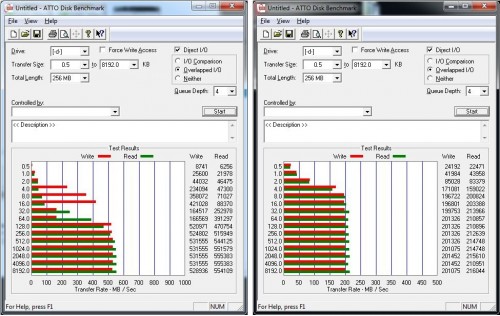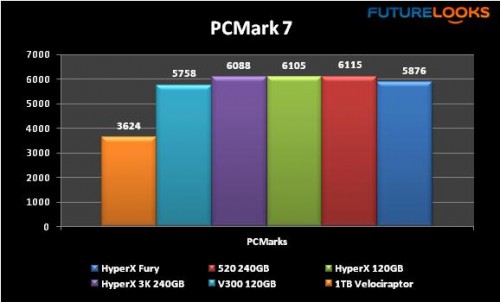SANDRA Physical Disk
First, we get a look at Read bandwidth. The Fury reads at 516 MB/s versus the fastest platter, a WD Velociraptor, which clocks in at 162 MB/s. Write performance was 218 MB/s versus 130 MB/s on the platter’s best score. Note that the HyperX Fury’s .04 latency score versus the Velociraptor’s 5.33 ms latency, which gives SSDs a major edge.
Blackmagic Disk Speed
 HyperX Fury (left) and WD 1TB Velociraptor (right)
HyperX Fury (left) and WD 1TB Velociraptor (right)
We see that the HyperX Fury (left) is considerably faster when it comes to the possible bandwidth needed to write live content. The Fury can support a lot more video formats because it has the bandwidth capabilities that even a Velociraptor doesn’t possess. Regular hard drives will even slower.
CrystalDiskMark
 HyperX Fury (left) and WD 1TB Velociraptor (right)
HyperX Fury (left) and WD 1TB Velociraptor (right)
When it comes to compression and managing serious data, the HyperX Fury is about as fast as any other affordable SSD that we’ve seen in labs. The reason most SSDs seem so responsive are because of the 4K scores, which are very respectable. In fact, the HyperX Fury runs circles around the Velociraptor, as does most SSDs of this caliber.
Just for comparison, the HyperX Fury’s older HyperX 3K Black brother can read at just over 530 MB/s and top 500 MB/s in Sequential tests, which isn’t that far off.
ATTO Bench
 HyperX Fury (left) and WD 1TB Velociraptor (right)
HyperX Fury (left) and WD 1TB Velociraptor (right)
IO is more important to server administrators rather than regular enthusiasts. If you were in a pinch and needed an SSD to host some services, the Kingston HyperX Fury still does quite well and much better than the 1TB Velociraptor as expected. Of course, for extended use, we still recommend an Enterprise level drive due to its extended compatibility testing and higher MTBF (mean time before failure) rates. Although the Kingston HyperX Fury is no slouch at 1 million hours.
PCMark 7 Overall System Performance
Finally, the scores here reveal how storage can influence overall system performance. All of the sub systems and applications make input/output requests so often that bandwidth makes all the difference. So essentially, we see the Kingston HyperX Fury’s IO performance in action. It noticeably out paces the Kingston V300, which is the company’s previous entry level offering.
Final Thoughts
The Kingston HyperX Fury 240GB SSD is a good step for entry level enthusiasts whether they be gamers or pro desktop users looking for faster performance overall. Probably more important than any other performance aspect is its influence on overall system response. Not only will your PC boot faster, but your games (and applications) will load so much quicker. In our lab, the Fury manages to boot to desktop (after the BIOS loads) in about 14 seconds. It also loads MS Office in about 2 seconds.
And for fun, Battlefield 4 loads quickly enough that the HyperX Fury powered system was often one of the first to spawn in game which is great if you like tanks, choppers, or want to be the first sniper in a good position. So if your system can’t do any of these things, you definitely need an SSD today.
The performance gains are tangible, and if your budget is limited, even the $130 US is affordable for the 240GB model. Lower than that, you can grab yourself the 120GB model at around $70.00 US. But given the entry level pricing and targeting, we really would like to see a bundle that includes the extras, so that folks can successfully upgrade on their own.
Pros
- Respectable performance
- Competitively priced (240GB for $130/120GB for $70)
- Faster than the fastest platters
- Spacer included for 9.5mm bays
- Easy to setup
Cons
- Doesn’t come in a 480GB capacity
- Product sticker doesn’t stick so well
- An entry level bundle with tools/software would be great
Overall Rating: 8.75 / 10.0

Help Us Improve Our Reviews By Leaving a Comment Below!




